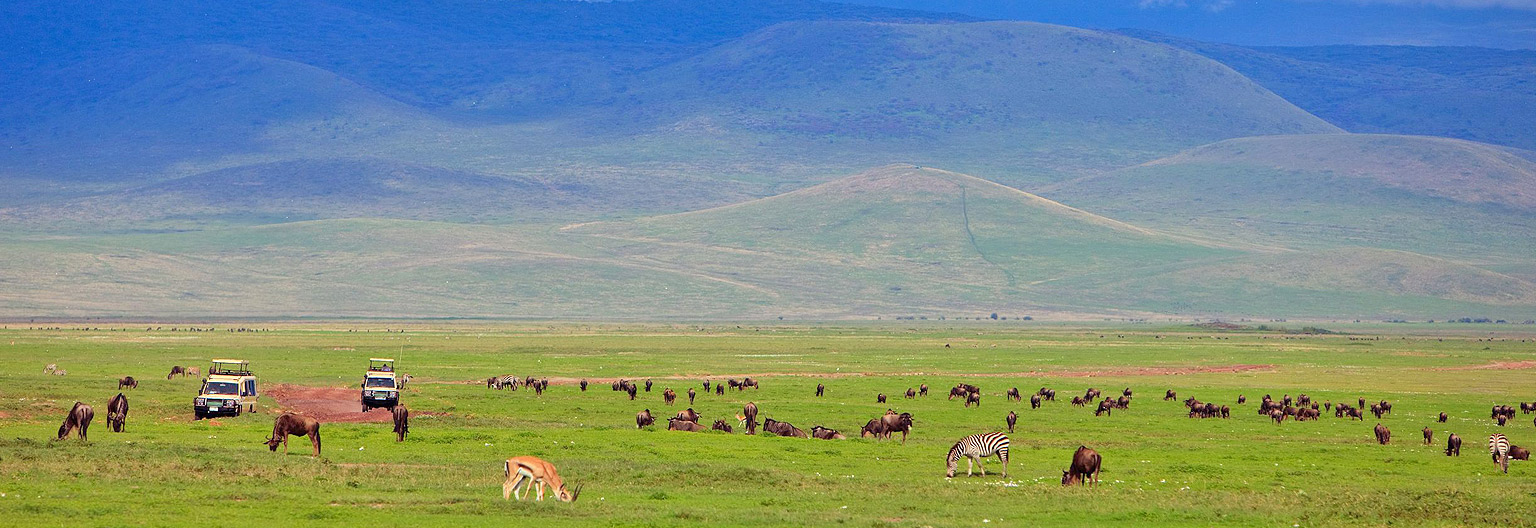
Due to the enclosed nature of the Crater it has virtually formed its own ecosystem. Besides the stunning scenery, one of the main attractions of this area is the variety of flora and fauna found in a remarkably compact area all year round. In the South west corner there is the Lerai Forest, which is mainly comprised of yellow fever trees (a member of the acacia family). To the north of the forest is a shallow soda lake called Lake Magadi and to the east you will find Gorigor Swamp and the Ngoitokitok Springs where pods of hippo are to be found. The north of the Crater is, on the whole, much drier and consists of the open grasslands which characterizes the Crater floor; this is where the majority of the resident game resides.
You are guaranteed to see large concentrations of game on any Ngorongoro safari. The mineral-rich floor of this spectacular bowl is largely flat, open and covered in nutritious grasses – much to the liking of large herds of zebra and wildebeest, which graze here.  These extensive open plains are also home to herds of buffalo, Thomson’s gazelle, Grant’s gazelle and Tsessebe (often called topi). You’ll also find East Africa’s best population of black rhino here, which are often seen in open grasslands. Breeding herds of elephant pass through the Ngorongoro Crater itself only rarely, but you will see a scattering of old bulls, including some of the biggest tuskers left alive in Africa today. The only surprising absentees from the Crater are Impala and Giraffe; it is thought that this is perhaps because of the lack of open woodlands and browsing species of trees which these two tend to thrive on.
These extensive open plains are also home to herds of buffalo, Thomson’s gazelle, Grant’s gazelle and Tsessebe (often called topi). You’ll also find East Africa’s best population of black rhino here, which are often seen in open grasslands. Breeding herds of elephant pass through the Ngorongoro Crater itself only rarely, but you will see a scattering of old bulls, including some of the biggest tuskers left alive in Africa today. The only surprising absentees from the Crater are Impala and Giraffe; it is thought that this is perhaps because of the lack of open woodlands and browsing species of trees which these two tend to thrive on.
The high numbers of herbivores supports the densest populations of predators found anywhere in Africa. The reliable presence of these predators has helped to make an Ngorongoro safari so popular. The Crater’s lion population varies significantly over time, the one constant being their complete disregard of vehicles; they will hunt within yards of a vehicle, and when exhausted even seek shade beside them. Spotted hyenas are even more common here, often competing with the lion, and there’s are a small but growing number of cheetah. Leopards are around, especially in the vicinity of the Lerai Forest. Side-striped and the lovely golden jackal are often seen skulking around, whilst bat-eared foxes are a rarer sight.
Having waxed lyrical about the Ngorongoro Crater’s wildlife, the reality of safaris there isn’t always as amazing. The sheer number of vehicles in the crater, combined with its open environment, can destroy any sense of wilderness. It can feel crowded and busy. Often, this will be mitigated by amazing game sightings, but not always. So whilst the Ngorongoro’s wildlife is stupendous, the Ngorongoro Crater safari experience isn’t always as good as you might imagine.

